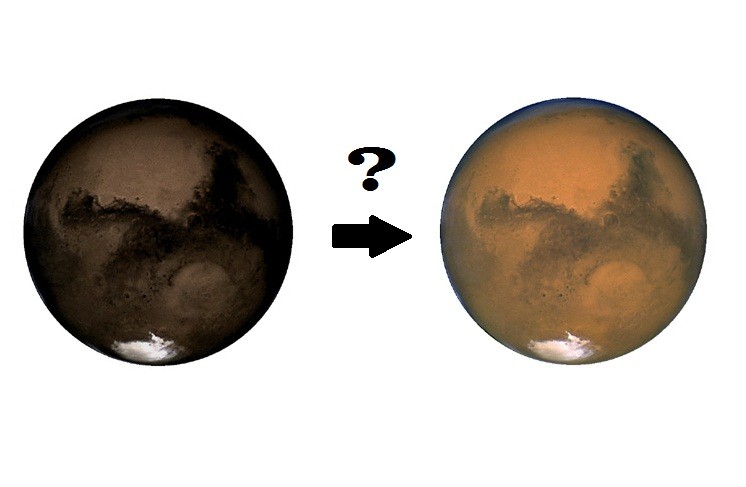Mars, often called the Red Planet, immediately captures our attention with its distinctive rusty hue. As the Curiosity rover and other Mars missions continue to send back breathtaking images of the Martian landscape, the question naturally arises: Why Is Mars Red? The answer, while seemingly simple, delves into the fascinating geology and atmospheric processes of our celestial neighbor.
 The rusty red surface of Mars, as seen by the Hubble Space Telescope, showcasing the planet's distinctive coloration due to iron oxide.
The rusty red surface of Mars, as seen by the Hubble Space Telescope, showcasing the planet's distinctive coloration due to iron oxide.
The Simple Explanation: Iron Oxide on the Martian Surface
The most straightforward explanation for Mars’s reddish color lies in its regolith, the loose layer of dust and rock covering the planet’s surface. This Martian soil is rich in iron oxide, a chemical compound also known as rust. Iron oxide is the very substance that gives blood its red color and causes metal to rust here on Earth. But the story doesn’t end there; understanding why Mars has so much iron oxide requires a journey back to the solar system’s formation.
Forged in Stars: The Origin of Iron on Mars
Billions of years ago, as our solar system was taking shape, a cloud of gas and dust, remnants of ancient stars, began to coalesce. These stars, in their final stages, forged heavy elements like iron in their cores before scattering them across the cosmos when they died. Mars, like other planets, inherited a significant amount of this iron. Unlike Earth, where much of the iron sank to the planet’s core during its molten youth due to gravitational differentiation, Mars’s smaller size and weaker gravity allowed iron to be more dispersed throughout its layers, including the upper crust and surface.
The Oxidation Mystery: How Did Mars Get Rusty?
While the presence of iron explains the “iron” part of iron oxide, the “oxide” part – the combination of iron with oxygen – is a more complex puzzle. Pure iron is typically a shiny, dark gray metal. It only turns reddish when it undergoes oxidation, reacting with oxygen to form iron(III) oxide (Fe₂O₃). Scientists are still actively researching the exact mechanisms that led to the widespread oxidation of iron on Mars. Several theories attempt to explain this Martian rust formation:
Ancient Water and Weathering
One prominent theory suggests that in Mars’s early history, when liquid water is believed to have flowed on its surface, rainstorms could have played a role in rusting the iron. Water molecules could have broken down, releasing oxygen atoms that then reacted with the iron-rich regolith, gradually leading to oxidation.
Slow Oxidation Over Billions of Years
Another hypothesis proposes a slower, more prolonged oxidation process. Over billions of years, sunlight could have broken down molecules like carbon dioxide and water vapor in the Martian atmosphere, releasing oxidants such as hydrogen peroxide and ozone. These oxidants could have then slowly reacted with the surface iron, causing it to rust over eons.
Dust Storms as Rust Accelerators
Intriguingly, a team of Danish scientists proposed in 2009 that Martian dust storms might be a key factor in the oxidation process. They suggested that the abrasive action of dust storms, containing quartz crystals, could grind down the Martian regolith, exposing fresh, oxygen-rich surfaces of these crystals to iron and accelerating the rusting process.
Why Iron Oxide Appears Red: The Science of Light
Regardless of the precise oxidation mechanism, iron(III) oxide’s characteristic red color is due to how it interacts with light. When sunlight strikes iron oxide, the compound absorbs the blue and green wavelengths of the light spectrum while preferentially reflecting the red wavelengths. This selective absorption and reflection of light is why we perceive iron oxide, and consequently Mars, as red.
A Red Planet Across Cultures: Historical Perspectives
The striking red color of Mars has been noted and named by civilizations throughout history. The Romans, associating the color with blood and war, named the planet after their god of war, Mars. Similarly, ancient Egyptians called it “Her Desher,” meaning “the red one,” and early Chinese astronomers referred to it as the “fire star,” all recognizing and highlighting the planet’s dominant reddish appearance.
The Enduring Mystery of Mars’s Red Hue
In conclusion, while we know that iron oxide is responsible for Mars’s red color, the exact processes that led to such widespread oxidation remain a topic of scientific investigation. The Red Planet’s hue, visible across vast distances, is a testament to the fascinating geological and atmospheric history of Mars, a history that continues to unfold as we explore this captivating world further.
